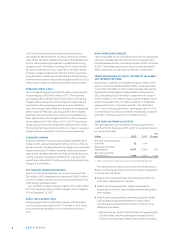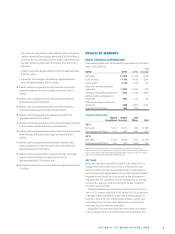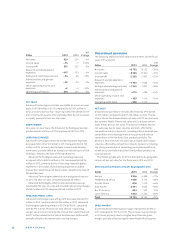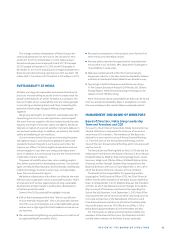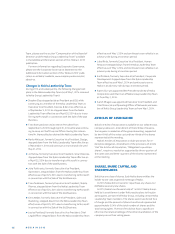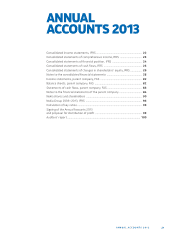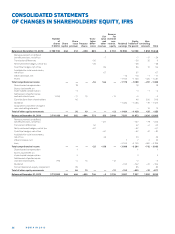Nokia 2013 Annual Report Download - page 20
Download and view the complete annual report
Please find page 20 of the 2013 Nokia annual report below. You can navigate through the pages in the report by either clicking on the pages listed below, or by using the keyword search tool below to find specific information within the annual report.NOKIA IN 2013
18
■ Our HERE business includes various risks and uncertainties,
including that we may be unable to maintain current sources
of net sales in the vehicle segment from which our HERE
business has historically derived most of its net sales from,
establish a successful location-based platform, extend
our location-based services across devices and operating
systems or create new sources of revenue.
■ Our sales, profi tability and cash fl ow are dependent on the
development of the mobile and communications industry in
numerous diverse markets, as well as on general economic
conditions globally and regionally.
■ Networks is dependent on a limited number of customers
and large multi-year contracts and accordingly a loss of a
single customer or issues related to a single contract can
have a signifi cant impact on Networks.
■ We may be unable to retain, motivate, develop and recruit
appropriately skilled employees.
■ We have operations in a number of countries and, as a result,
face complex tax issues and could be obligated to pay ad-
ditional taxes in various jurisdictions. Further our actual or
anticipated performance, among other factors, could reduce
our ability to utilize our deferred tax assets.
■ We may fail to manage our manufacturing, service creation
and delivery, as well as our logistics effi ciently, and without
interruption, or the limited number of suppliers we depend
on may fail to deliver suffi cient quantities of fully functional
products and components or deliver timely services meeting
our customers’ needs.
■ The Sale of the D&S Business may expose us to contingent
liabilities and the agreements we have entered into with
Microsoft may have terms that prove to be unfavorable to us.
■ Our operations rely on the effi cient and uninterrupted op-
eration of complex and centralized information technology
systems and networks and we store certain personal and
consumer data as part of our business operations. If a sys-
tem or network ineffi ciency, cybersecurity breach, malfunc-
tion or disruption occurs, this could have a material adverse
eff ect on our business and results of operations.
■ Our eff orts aimed at managing and improving fi nancial per-
formance, cost savings and competitiveness may not lead to
targeted results or improvements.
■ Networks may be adversely aff ected by negative develop-
ments with respect to the customer fi nancing or extended
payment terms it provides to customers.
■ If any of the companies we partner and collaborate with were
to fail to perform as planned or if we fail to achieve the col-
laboration or partnering arrangements needed to succeed,
we may not be able to bring our products or services to
market successfully or in a timely way.
■ Our products and services include increasingly complex
technologies, some of which have been developed by us or
licensed to us by certain third parties. As a result, evaluating
the rights related to the technologies we use or intend to
use is more and more challenging, and we expect to con-
tinue to face claims that we could have allegedly infringed
third parties’ intellectual property rights. The use of these
technologies may also result in increased licensing costs for
us, restrictions on our ability to use certain technologies in
our products and/or costly and time-consuming litigation.
■ We are a company with global operations and with sales
derived from various countries, exposing us to risks related
to regulatory, political or other developments in various
counties or regions.
■ Our net sales, costs and results of operations, as well as
the US dollar value of our dividends and market price of our
ADSs, are aff ected by exchange rate fl uctuations, particu-
larly between the euro, which is our reporting currency, and
the US dollar, the Japanese yen and the Chinese yuan, as
well as certain other currencies.
■ We may not be able to achieve targeted benefi ts from or
successfully implement planned transactions, such as acqui-
sitions, divestments, mergers or joint ventures, for instance
due to issues in selecting successfully the targets or failures
to execute transactions or due to unexpected liabilities as-
sociated with such transactions.
■ An unfavorable outcome of litigation, contract related
disputes or allegations of health hazards associated with our
business could have a material adverse eff ect on our busi-
ness, results of operations, fi nancial condition and reputa-
tion.
DIVIDEND AND PLANNED EUR 5 BILLION
CAPITAL STRUCTURE OPTIMIZATION
PROGRAM
As announced on April , , as a result of the closing of
the Sale of the D&S Business, Nokia’s fi nancial position and
earnings profi le have both improved signifi cantly. Furthermore,
Nokia’s Board of Directors has conducted a thorough analysis
of Nokia’s potential capital structure requirements. Based
on this analysis, the Nokia Board is confi dent that Nokia has
the fi nancial strength and fl exibility to sustain the long-term
investments necessary to ensure industry leadership in the
future.


